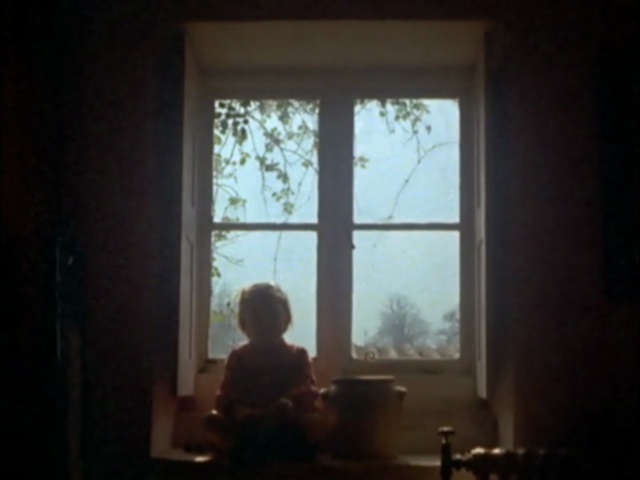Looking back at Peter Greenaway’s 1975 short Windows, it’s startling to notice how much its matter-of-fact tone matches today’s, where matter-of-fact acceptance of the unthinkable is pretty much expected in a movie-going public that might be described as “desensitized.”
Perhaps what Greenaway is up to is “re-sensitizing,” through irony. Scene after scene, the camera simply observes a window through Baroque and Flemish painting-inspired static shots. Sometimes a character is in the frame (a child looking out the window, a seamstress dillydallying in the yard) and at other times, the main point of action comes from natural sources (the colors of the sky, sunlight). In each scenario it’s Greenaway’s impeccable delivery in describing how the 37 poor souls of a certain parish “W” died (e.g. “Two fell through misadventure, two were drunk, one was pushed…”) that breathes life and horror into the film’s otherwise inanimate compositions. We the audience can never really register just how morbid the narrative actually is.
With my video essay, I wanted to challenge the film’s sense of the macabre on a meta-movie level. Since the physical window acts as a catalyst for action that we never see in Windows, I went ahead and superimposed (with a lowered opacity) specific, window-centric scenes from movies that were released after 1975. In each new scene, the window acts as a life-changing event (an act of violence, an escape or a plunge towards death). By juxtaposing images that are moving away from each other in ideas (the inaction of Windows vs. the action of the new films), Greenaway’s voiceover performance suddenly becomes a different beast. He goes from a witty, obscenely ironic parish tour guide to unsympathetic omniscient narrator. It’s the crudest of developments and digs a little at the overabundance of fatalistic imagery in the modern cinema canon. These days, we’re almost immune to the sight of death in movies. How else can one explain such mainstream movie phenomena as Saw through Saw VII 3D?
Because of this, Windows exists as a cultural embryo for tell-don’t-show cinema—and is disarmingly vital for that very reason.
Video: ‘The Macabre Mis-en-Scene of Peter Greenaway’s WINDOWS’
Full Transcript of Peter Greenaway’s Windows (1975):
In 1973 in the parish of “W,” 37 people were killed as a result of falling out of windows. Of the 37 people who fell, seven were children under 11, 11 were adolescents under 18 and the remaining adults were all under 71—save for a man believed by some to be 103. Five of the seven children fell from bedroom windows, as did four of the 11 adolescents and three of the 19 adults. Of the seven children who fell all cases were of misadventure save for one of infanticide. Of the 11 adolescents, three committed suicide for reasons of the heart, two fell through misadventure, two were drunk, one was pushed, one was accredited insane, one jumped for a bet and one was experimenting with a parachute. Of the 18 men, two jumped deliberately, four were pushed, five were cases of misadventure and one, under the influence of an unknown drug, thought he could fly. Of the 11 adolescents who fell, two were clerks, two were unemployed, one was married, one was a window cleaner and five were students of aeronautics, one of whom played a harpsichord. Among the 19 adults who fell were an air-stewardess, two politicians, an ornithologist, a glazier and a seamstress. Of the 37 people, 19 fell in summer before midday, eight fell on summer afternoons and three fell into snow. The ornithologist, the adolescent experimenting with the parachute and the man who thought he could fly, all fell or were pushed in spring evenings. At sunset on the 14th of April 1973, the seamstress and the student of aeronautics who played the harpsichord jumped into a plum tree from the window in this house.




